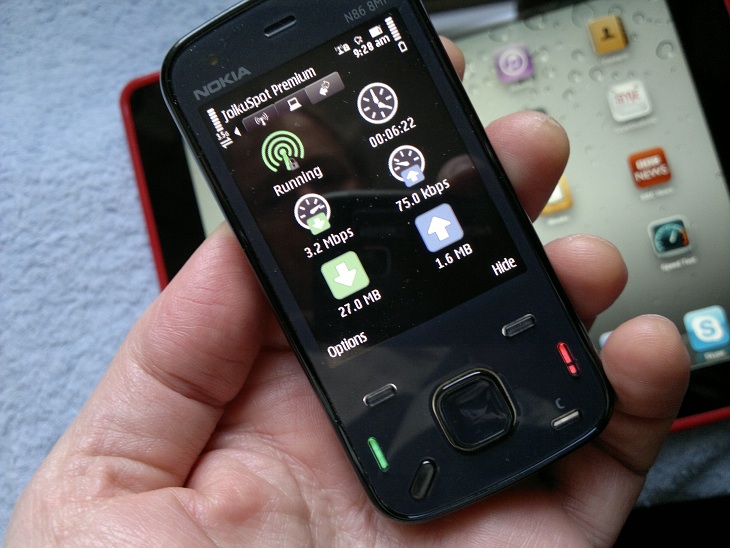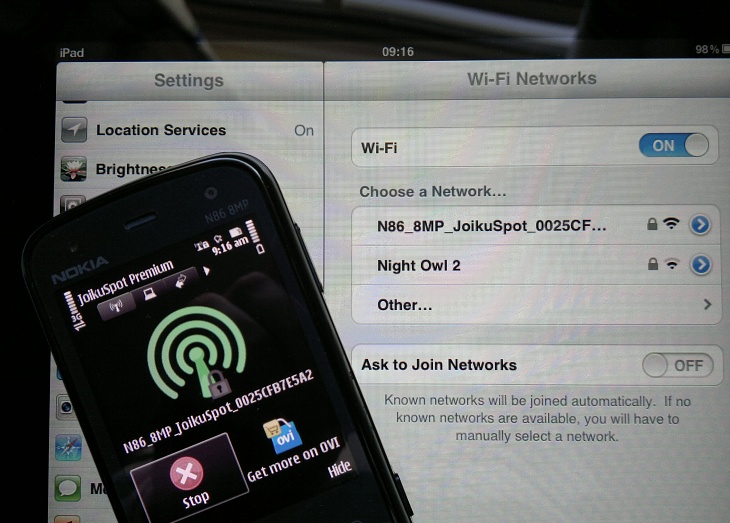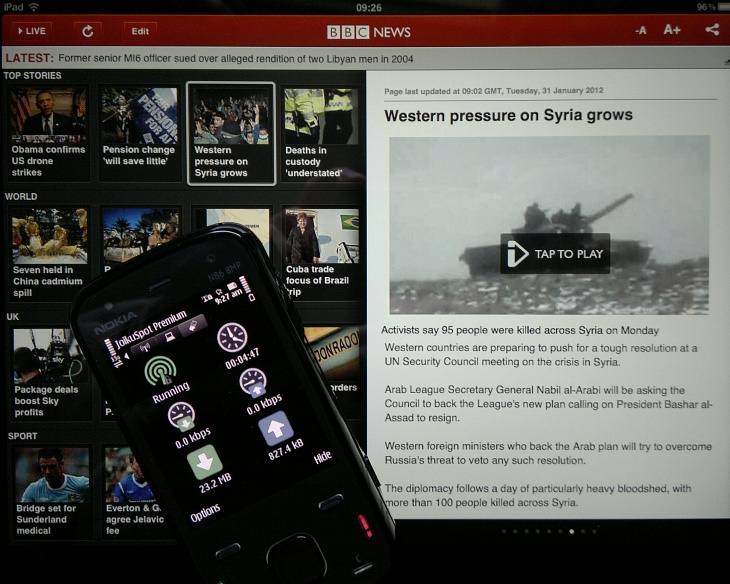Published by Steve Litchfield at 11:14 UTC, January 31st 2012
Summary:
12 years ago, I remember demonstrating to a packed room of enthusiasts to delights of pairing up my Psion palmtop with the Ericsson SH888 (titanium, indestructible), which possessed an infrared modem, meaning that I could get my palmtop online at a whopping 9.6kbps via Circuit Switched Data (this was before GPRS!) It was a working two box communications solution and it's with a certain nostalgia that I remember it as I look a modern 'two box' solution. How do the pros and cons of splitting one's electronics work out in practice?
At the same meeting, I remember a friend (who worked at Symbian) indicating (under his jacket) the very first Nokia 9210 prototype and (quietly) decrying my two box system as old hat. And he was right, of course, the 9210 launched in 2000 and the world of smartphones was born (a full seven years before the iPhone - tell that to your kids, and they won't believe you, etc...)
But that's never stopped many people wondering, ever since, whether a two box solution is practical. These days, the phone and data parts are built into everything, of course, so the 'two box' bit refers to form factor and capabilities. With 'smartphones' getting ever larger (I've just been reviewing the Samsung Galaxy Nexus and Galaxy Note, at 4.65" and 5.3" screen respectively), to the point where they are actually quite clumsy to use as 'phones', is there now a case for returning to the two box concept and splitting the main functions of communications and display?

In this feature, I'm going to be looking at combining a Nokia N86 (chosen because of its terrific camera, great/traditional 'phone' form factor, and because it's great for music) with an Apple iPad 2 (great for games, applications, Web, email and social networking). So as not to duplicate functions and expense, I'm obviously looking at the Wi-fi-only version of the latter, using Joikuspot Premium on the N86 to provide mobile broadband to the tablet.
Is this the best of both worlds or simply a clumsy and inefficient solution? Would I not be better off with a one box system such as the Galaxy Note? Let's investigate.
Here's the set up then, the top rated (by me, at least) but somewhat ageing Nokia N86, showing JoikuSpot Premium in action, and the 2011 Apple iPad 2:

| N86/iPad 2 | Samsung Galaxy Note | |
| Cost | £100 second hand (too old to find new), plus £400 new. Total = £500 | £550 new |
| Form, bulk, overall weight | Two devices, obviously, one will be cases/pocketed, one will be in your bag or briefcase, total weight 650g | One single device, though you'll need a large pocket - suit jackets will work quite well, as will a handbag of some kind. Weight 178g |
| Display and relevant specs | 2.6" display on phone, 1200mAh battery, replaceable, 10" display on iPad, around 7000mAh battery | 5.3" display, 2500mAh battery |
| Usable battery life | The N86, running JoikuSpot all the time, will need you to swap to a second battery halfway through the day - and then you'll have to charge both batteries at night; the iPad 2 should also be charged at night. | A full working day, easily, with charging overnight. |
| Calls, video calls | Taking phone calls is a doddle, of course, on the N86, and very discreet, by modern standards. Physical call/hangup keys, too. iPad obviously not needed unless you want to max out bandwidth and try a Skype or Facetime video call - the iPad 2's front-facing cam is very good for this (the Symbian phone can only video call using the niche Fring system). | Taking a voice call on the Note looks somewhat comical, but can be done. Longer calls will need the wired headset or a Bluetooth headset. Video calls work well, bandwidth-permitting, using Skype, Google Hangout or a number of other niche systems. |
| Email and Symbian have never gone together all that smoothly, especially on S60 3rd Edition - certainly the experience is far faster and more productive on the JoikuSpot-connected iPad 2 using the built-in Mail client or even a webmail page. | Android's email handling is a trifle uneven, with separate Gmail and generic Email applications, but does all work well in the end. The 5.3" screen is large enough to handle incoming emails and Polaris Office is on hand to handle attachments. | |
| Working on the Web | The N86 itself is fine for mobile web lookups (I have this page set as my starting page), but the bottle neck is the Symbian phone's processor and web rendering code, so most people will get on better using the connected iPad 2 and its Safari web browser. There's no Flash support and Javascript compatibility is somewhat less than desktop-perfect, but it's enough for many people not to need to break out a genuine laptop. | The web browser on the large-screened Note is really pretty good and supports more pages than the iPad, including most Flash sites. And there's decent integration with other applications, any of which can launch you off into the browser as needed. |
| Navigation | Nokia Maps 3.6 provides superb real time navigation on the phone - no involvement needed from the iPad. The N86 is also a doddle to mount in just about any car phone holder. | The Note includes a GPS and Google Maps Navigation now works for many countries. It's functional, but not as polished as Nokia Maps in my experience. You may have to think laterally about how to place the Note in your car, due to size and relatively thin form factor. |
| Social networking | Although Gravity on the N86 is ok for quick photo uploading or catching up on Twitter mentions, etc, the small, non-touch screen isn't really conducive to flying around social networks. Best to break out the iPad 2 and use one of the many iOS Twitter and Facebook clients, all running full-screen. More options than you'll ever want to try. | Social network support is extensively built into Samsung's extensions to Android, integrating into Contacts and much more. Plus a dozen or more Twitter, Facebook and clients for every other social network. An Android highlight. |
| Music | Sound quality from the N86 is excellent over headphones, i.e. using the phone as a high quality music player, even with JoikuSpot active and transmitting. There's also the option of FM transmission to the car's radio (works well outside big cities). (Music playback is also possible via the iPad, though you have to remember to sync it through iTunes. Streaming music is possible via various iPad applications, while you're working, if you have the bandwidth.) | Sound quality is excellent over headphones and will play happily in the background while you work. Android has plenty of streaming music options, from custom services to Internet Radio. |
| Movies | The iPad 2 is pretty good for video content bought through iTunes or video podcasts sideloaded (I wasn't silly enough to try streaming HD YouTube content via weedy UK 3G...) And you can't beat watching on a 10" screen, of course. | The Note is superb for video use, allowing simple sideloading of any MP4 or similar content, direct downloading of video podcasts, etc. The screen may only be 5.3", but held at around 30cm from the eyes it's still a sumptuous experience. |
| Photos/Video capture | The N86 camera is almost unmatched, of course, use this for the serious photos for working on later; the iPad 2 camera's not that bad and certainly good enough for fun shots for immediate upload through the aforementioned iOS social networking apps. Video capture is good but low-res (VGA) from the N86, and 720p from the iPad 2, though holding a 10" tablet up to shoot a video is a real pain! | With the same camera as the Galaxy S II, the Note takes stonkingly good photos in most light conditions, I'd rate it as good as the N86's, with the proviso that you've got to stop to wipe the camera 'glass' each time. Video capture is very practical at up to 1080p, and with high quality sound, up to the N86's standard. In addition, Samsung provides an 'Outdoor' mode for the display, boosting the AMOLED to silly levels to make sure that you can see what you're snapping or shooting, even in bright sunlight. |
| Gaming | Games for the Nokia are relatively simple and limited, but the iPad 2 is currently arguably the world's premier mobile gaming device, with its large screen and touch interface, and with tens of thousands of quality game titles. | The Android gaming scene is growing, but held back slightly by the wide range in screen resolutions. Find a title you like and you're off and running, but the gaming can't get close to that on the iPad. |

The whole two-versus-one argument is extremely subjective, of course, which is why I haven't awarded any 'wins' above. I did think it notable that the two box solution costs less than the single device tested, plus there's the flexibility that if one component fails (e.g. the phone) then you can switch to another while retaining the other major component (e.g. the iPad). In fact, the presence of an older iPad model (with slower processor, less RAM and no camera) means that a budget two box solution could be achieved for around £250, sourced second hand.
On the other hand, the 'one box' solution has the advantage that everything's supremely integrated and you never have to fiddle about getting one component online:

Definitely a case of pros and cons for each. The possibility of combining the best bits, the strengths of an older, now cheaper Symbian smartphone and the arch-tablet of our times, the iPad, did appeal to me though. You really can have a phone which is phone-sized and with the usual Symbian strengths of decent battery performance, navigation and great audio, while also having a huge screen for work, reference, gaming and entertainment.
One possible big flaw for the two box approach is battery life - if you're intending to stay online on the iPad for most of the day, then the effort of keeping the ad-hoc Wi-fi hotspot going will kill the phone battery several times over. The N86's battery life isn't great at the best of times and it's really only suitable for running a hotspot in short bursts. You can't just leave it 'on' and active all day. If I were to repeat the experiment, I'd probably go for the Nokia E52 or E55, with the large BP-4L 'hero' battery.
My gut feel is that, although the two box solution produces a more expansive, more immersive and more flexible mobile computing system overall, issues of bulk, inconvenience and battery life mean that a good all-in-one 'converged' solution (and, trust me, the Galaxy Note is one such) edges it overall. Comments welcome if you agree, if you disagree, or if you've tried something similar!
Steve Litchfield, All About Symbian, 31st January 2012
PS. Bonus link to JoikuSpot Premium product page
blog comments powered by Disqus
No hay comentarios:
Publicar un comentario